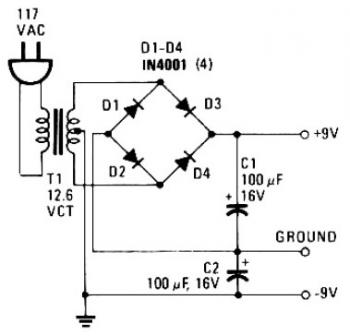This is a simple circuit design of 9V split power supply. This power supply circuit delivers plus and minus 9V to substitute the two 9V batteries. The rectifier circuit is certainly two separate full-wave rectifiers fed from the secondary of the transformer. One full-wave rectifier consists of diodes Dl and D2, which produce +9 V, and then the other consists of D3 and 4, which produce -9 V.
Every single diode from every pair rectifies 6.3 VAC, half the secondary voltage, and charges the concerned filter capacitor to the peak value of the AC waveform, 6.3 x 1.414 = 8.9 V. Every single diode ought to have a Peak Inverse Voltage (PIV), rating which is at least twice the peak voltage from the transformer, 2x8.9=18 V. The 1N4001 features a PIV of 50V.
The transformer type is step down transformer with input / primary of 120V. You should be replace the transformer if your home electrical installation is use 220V.

Comments